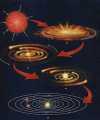The Astronomical Unit
The diagrams on the right show this process of the cloud condensing into a disk, and forming the Sun, the planets and all the other bodies associated with the Solar System. The four planets closest to the sun are rocky and formed, predominantly, from dust, while the outer four planets are gas giants, and formed far enough from the sun that it was cold enough for gases to freeze into ice, so the planets became a mixture of ices, dust and gas molecules. Jupiter and Saturn have more gas, while Uranus and Neptune are closer to being ice giants as they have much higher content of frozen gases. In the early history of the Solar System, the planets were in very different orbits around the sun than they are today. The three outer planets, Saturn, Uranus and Neptune were closer to the sun and migrated outwards. It is possible that some of them have changed places since their formation.
Our solar system, centered on the sun, comprises 8 planets. It includes an asteroid belt and the Kuiper belt, which includes Pluto and its companion Charon, and a number of other "plutoids" or dwarf planets. Beyond the Kuiper Belt lie the Scattered Disc Objects (SDOs) and Detached Objects (DOs), and beyond that the Oort Cloud from which most of the long period comets are believed to originate.
Solar System -
Introduction
Astronomers estimate that the solar system first formed about 4.55 billion years ago. The most widely accepted model is the Nebular hypothesis. This theorizes that a part of a large molecular cloud gets disrupted, possibly from a nearby supernova, and starts to collapse and contract due to gravity. The contraction causes the cloud to heat up, particularly towards the center where the material becomes concentrated. Eventually, the temperature at the center is sufficient to start nuclear processes, and a star is born. Not all the gas falls into the star, and the rest flattened and formed an accretion disk around the star. The disk starts to cool and condense into particles. These particles collide and form larger and larger particles eventually forming rocks and then asteroid sized objects. These accrete smaller particles and continue to grow. This may have taken only a few million years from the time the cloud started to contract. In some cases, the moons condensed from gas orbiting the planet, while others formed independently and were captured later by a planet; for example, this is how Mars is thought to have obtained its two moons. The Earth's moon was probably the result of a cataclysmic collision with another object possibly half the diameter of Earth itself. This produced a jet of material that condensed into the moon.
Image Credit: aerospace web.
•
The Solar System Portal in Wikipedia also has extensive resources well beyond my introductory look!
•
Views of the Solar System contains a great deal of information plus some stunning photographs from various sources.
•
NASA's Solar System Exploration site is packed with information and photographs.
Formation
Solar System Links
I am introducing a new unit of measurement in this section; the Astronomical Unit. It is equal to the average distance between the Earth and the Sun, 92,955,807 miles (149,597,870 km) usually rounded to 93 million miles or 150 million km. Astronomers regularly use it to indicate distances within the Solar System, or for the radius of exo-planet orbits.



